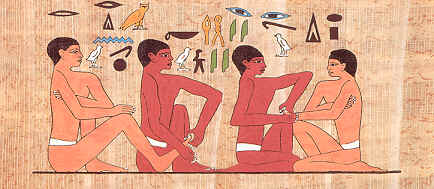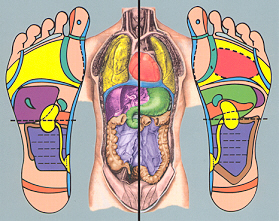
The hieroglyphics have been translated as: "Don't hurt me!"
The practitioner replies: "I shall act so you praise me."
Reflexology
History and Information

The hieroglyphics have been translated as: "Don't hurt me!"
The practitioner replies: "I shall act so you praise me."
The practice of reflexology may have a long history stemming
from the distant past. It seems in most ancient cultures there is a tradition of
working on the feet to help the body balance itself. Generally ancient cultures
have an oral tradition. However, some evidence of reflexology may be found in
art work. For instance, in Egypt, in the physician's tomb (2300 B.C.), there can
be found a pictograph which may be evidence of reflexology being applied. In
Asia, several examples also have been cited. Modern Reflexology is based on the
work of two American physicians, Dr. William Fitzgerald and Dr. Joe Shelby Riley,
of the 1920's and on that of physiotherapist Eunice D. Ingham, who developed
Fitzgerald and Riley's knowledge into a usable therapy, calling it Foot
Reflexology, and took it to the public in the late 1930's through the early 70's.
The scientific basis to Reflexology begins in the last century. In the 1890's,
knighted research scientist and medical doctor, Sir Henry Head demonstrated the
neurological relationship that exists between the skin and the internal organs.
Nobel prize winner, Sir Charles Sherrington proved that the whole nervous system
and body adjusts to a stimulus when it is applied to any part of the body.
Around the same time, in Germany, Dr. Alfons Cornelius observed pressure to
certain spots triggered muscle contractions, changes in blood pressure,
variation in warmth and moisture in the body, as well as directly affecting the
'physic processes,' or mental state of the patient. The Russians, beginning with
Drs Ivan Pavlov and Vladimir Bekhterev, have also been exploring reflex
responses in the body for nearly a century.

In the last 30 years, because of Eunice Inghams traveling around the country
teaching groups of people her method of reflexology (the Ingham Method), a
grassroots following of reflexology emerged in the US. In that time, practicing
reflexologists have emerged, more than 30 reflexology books have been published,
and the number of magazine articles published has risen by 500 percent since
1982. Television appearances by reflexologists have increased by 500 percent
since 1988.
Today recent research studies have been conducted around the world, including in
the US, which are validating the effectiveness of Reflexology on a wide variety
of conditions. Chronic conditions seem to respond especially well to
Reflexology. In China, where reflexology is accepted by the central government
as a means of preventing and curing diseases and preserving health, over 300
research studies have shown reflexology provided some improvement to 95% of the
over 18,000 cases covering 64 illnesses studied. In Japan and Denmark,
reflexology has been incorporated into the employee health programs of several
large corporations, saving each company thousands of dollars annually in paid out
sick leave benefits.
Many of our health problems can be linked to stress. It is an acknowledged fact,
by the medical community, that a body trying to function while under the
influence of prolonged stress is less capable of organizing its defenses against
illnesses and repair damage caused by injury. Stress can be either mentally,
emotionally, physically, or environmentally induced. Reflexology is primarily a
relaxation technique. Reflexology can negate the effects of stress while it
helps the body relax. Through the relaxation process the body is more capable of
dealing with the stresses placed on it by daily living and those associated with
illness. Reflexology gently nudges the body towards better functioning by
improving lymphatic drainage and venous circulation, stimulation to the nerve
pathways, and muscle relaxation.
While historically Reflexology has antidote been found to have a positive
affect on the body suffering from a wide variety of chronic problems, it is not
a panacea for all ills. Reflexology is not a substitute for medical treatment,
but can be used as a complement to any type of medical approach or therapy.
Reflexology can also be incorporated into an overall healthy lifestyle, which
includes attention to diet, moderate exercise, and different forms of stress
reduction and relaxation.

Reflexology is a unique modality in the health field. Its purpose is not to treat or diagnose for any specific medical disorder, but to promote better health and well-being in the same way as an exercise or diet program. Its practice should not be compared to massage or any other kind of manipulative procedure.
Reflexology is a science which deals with the principle that there are reflex areas in the feet and hands which correspond to all of the glands, organs and parts of the body. Stimulating these reflexes properly can help many health problems in a natural way, a type of preventative maintenance. Reflexology is a serious advance in the health field and should not be confused with massage.
Certainly, we have all made the statement, "My feet are killing me!" Ever wondered why? There are over 7,000 nerve endings in each foot, as compared to 26 bones, 33 joints, 107 ligaments, and 19 muscles in each foot.